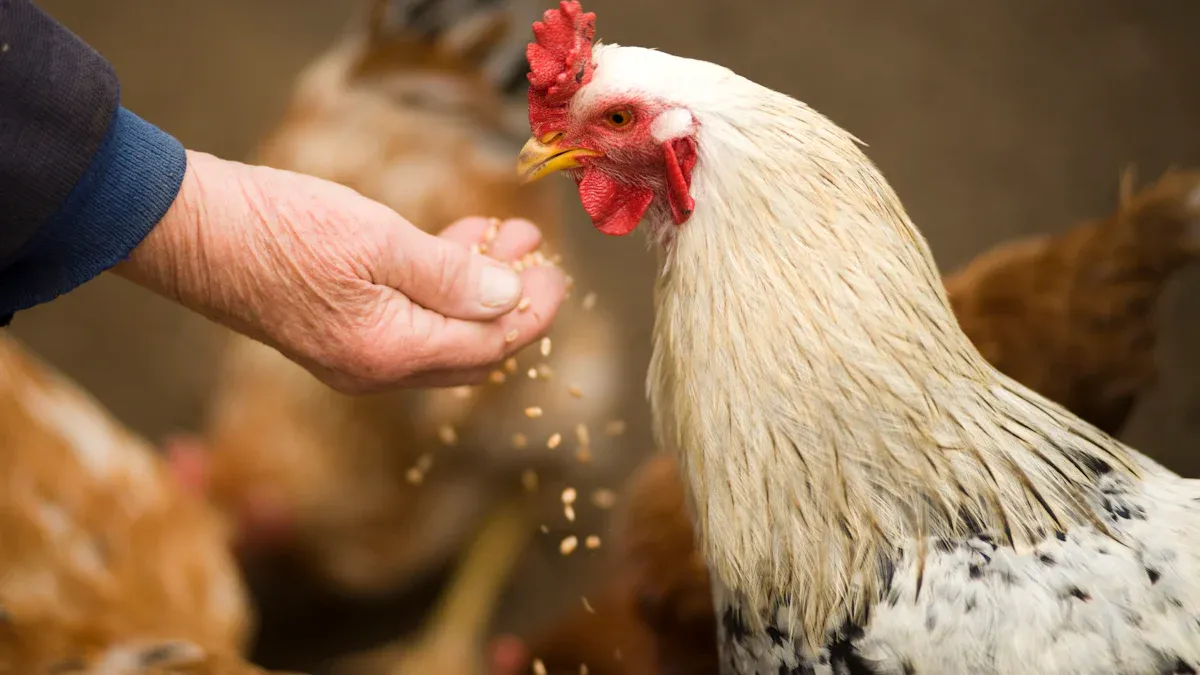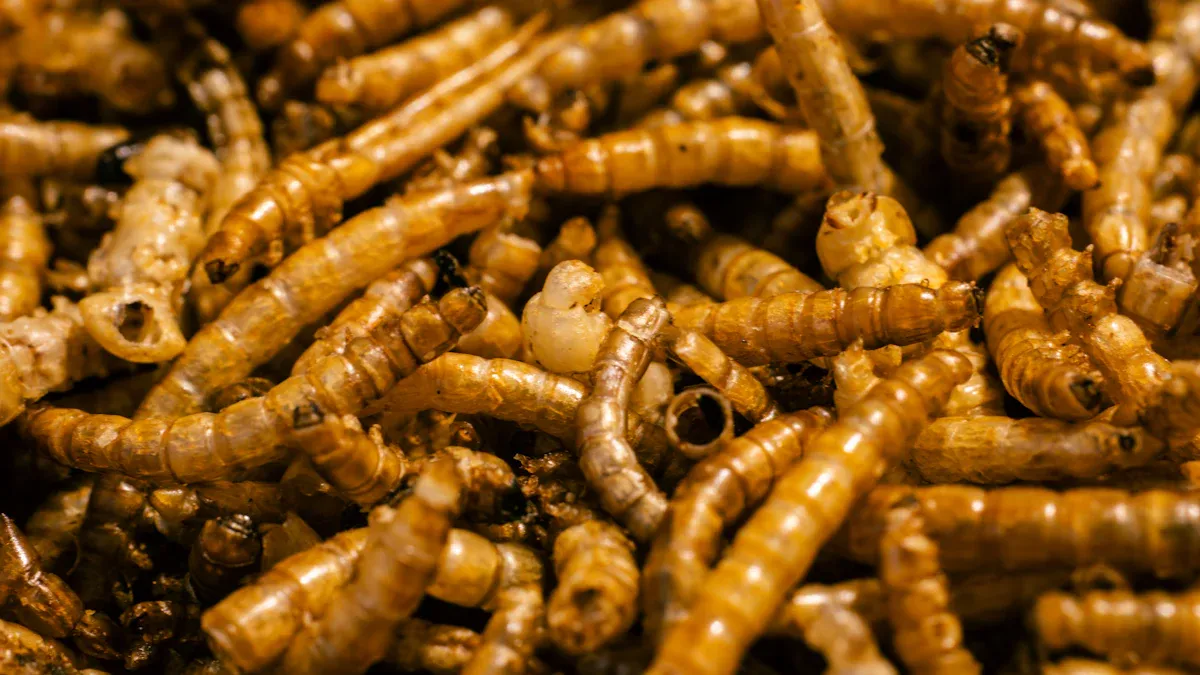
Farmers are turning to animal feed dried mealworms for their exceptional benefits. Packed with up to 54% protein, they surpass many traditional feeds. Studies show replacing 10% of a diet with mealworms improves weight gain and feed efficiency. Plus, mealworm farming uses less land and emits fewer greenhouse gases, making it eco-friendly.
Key Takeaways
- Dried mealworms have about 54% protein, helping animals grow strong.
- Adding mealworms to feed can save money and boost health.
- Mealworms are better for the planet, making farming more eco-friendly.
Nutritional Benefits of Animal Feed Dried Mealworms

High Protein Content for Growth and Energy
Animal feed dried mealworms are packed with protein, making them a powerhouse for growth and energy. Their protein content ranges from 48% to 54%, which is higher than many traditional feeds. Yellow mealworms, a popular variety, boast protein levels between 47.2% and 66.3%.
| Protein Content (%) | Range |
|---|---|
| Dried Mealworms | 48% to 54% |
| Yellow Mealworm | 47.2% to 66.3% |
This high protein concentration supports muscle development and energy production in farm animals. Studies show that replacing fish or soybean meal with mealworms leads to similar or even improved growth performance. Farmers can rely on mealworms to fuel their animals’ growth without compromising feed efficiency or intake.
Rich in Essential Fatty Acids, Vitamins, and Minerals
Dried mealworms offer more than just protein. They are rich in essential fatty acids, vitamins, and minerals that contribute to overall animal health. Their fat content is lower than pork and eggs but higher than beef, lamb, and fish, with a favorable unsaturated fatty acid profile.
- Minerals: Mealworms contain significantly higher levels of potassium, calcium, and magnesium compared to traditional feeds. For example, they provide 10 times more potassium than eggs and over 23 times more calcium than pork.
- Vitamins: Their vitamin E content is 4.4 times that of pork and 10.6 times that of milk.
These nutrients help animals maintain strong bones, healthy skin, and optimal metabolic functions. Adding mealworms to your feed plan ensures your animals get a balanced diet.
Supports Immune Health and Digestion
Mealworms also play a role in boosting immune health and improving digestion. Their well-balanced amino acid profile, including all essential amino acids except methionine, supports the immune system. Studies confirm that substituting fish or soybean meal with mealworms enhances digestibility and growth performance.
| Study | Findings |
|---|---|
| Toviho & Bársony (2022) | Substituting fish or soybean meal with mealworms led to improved growth performance. |
| Makkar et al. (2014) | Egg production increased by 2.4% with the use of dry mealworms. |
| Gasco et al. (2019) | Dietary insect meals significantly improved digestibility. |
Farmers can count on mealworms to keep their animals healthy and thriving. Their unique nutritional profile makes them an excellent choice for supporting immune health and digestive efficiency.
Cost-Effectiveness of Animal Feed Dried Mealworms
Long Shelf Life Minimizes Feed Waste
Dried mealworms have an impressive shelf life, making them a practical choice for farmers. Unlike fresh feed options, they don’t spoil quickly. This reduces the risk of feed waste, which can save money over time. Farmers can store mealworms for months without worrying about quality loss. This reliability ensures that animals always have access to high-quality nutrition, even during supply chain disruptions or seasonal shortages.
Competitive Pricing Compared to Other Protein Sources
Mealworms offer a cost-effective alternative to traditional protein sources like soy or fish meal. Their production requires fewer resources, such as water and land, which keeps costs lower. Additionally, mealworms provide excellent nutritional value, making them a smart investment for farmers. Studies highlight their efficient resource utilization, which positions them as an affordable and sustainable feed option. In a world facing food insecurity and environmental challenges, mealworms stand out as a reliable solution for livestock feed.
Enhances Feed Efficiency and Reduces Costs
Farmers often notice improved feed efficiency when using dried mealworms. Animals digest them easily, which means less feed is wasted. This efficiency translates to better growth rates and higher productivity, reducing overall feeding costs. For example, poultry fed with mealworms often show faster weight gain and improved egg production. By incorporating mealworms into their feeding strategy, farmers can achieve better results while keeping expenses under control.
Versatility of Animal Feed Dried Mealworms
Suitable for Poultry, Livestock, and Aquatic Animals
Animal feed dried mealworms are incredibly versatile. Farmers can use them to feed a wide range of animals, including poultry, livestock, and aquatic species. Chickens, for instance, benefit from the high protein content, which supports egg production and healthy growth. Pigs and cattle also thrive on mealworms, as they provide essential nutrients that improve overall health. Even fish and shrimp farms have embraced mealworms as a sustainable and nutrient-rich feed option. This adaptability makes them a valuable addition to any farm, regardless of the type of animals being raised.
Easy to Integrate into Existing Feed Plans
Farmers don’t need to overhaul their feeding strategies to include mealworms. These dried insects can be easily mixed with other feed ingredients or offered as a standalone treat. They come in various forms, such as whole dried mealworms or ground mealworm powder, making them simple to incorporate into different feeding systems. Whether it’s a small backyard farm or a large-scale operation, mealworms fit seamlessly into existing routines. Their convenience saves time and effort while ensuring animals receive high-quality nutrition.
Tip: Start by adding small amounts of mealworms to your current feed. Gradually increase the quantity to observe how your animals respond.
Year-Round Feed Option for Various Animals
Unlike seasonal feed sources, animal feed dried mealworms are available year-round. Their long shelf life ensures farmers always have access to a reliable protein source, even during times when other feeds might be scarce. This consistency is especially beneficial for farms in regions with harsh winters or unpredictable growing seasons. By providing a steady supply of nutrients, mealworms help farmers maintain productivity throughout the year.
Environmental Sustainability of Animal Feed Dried Mealworms
Low Carbon Footprint Compared to Traditional Feeds
Animal feed dried mealworms are an eco-friendly alternative to traditional feeds like soy or fish meal. Their production generates significantly fewer greenhouse gases, making them a sustainable choice for farms. For instance:
- Producing 1 kg of edible mealworm protein emits only 20.4 kg of CO2-eq.
- Non-renewable energy use is measured at 213.66 MJ-eq.
- Agricultural land occupation is just 22.38 m².
These numbers highlight how mealworms minimize environmental impact compared to conventional protein sources. By choosing mealworms, farmers can reduce their carbon footprint while maintaining high-quality nutrition for their animals.
Promotes Circular and Sustainable Farming Practices
Mealworms contribute to circular farming by turning organic waste into valuable protein. They thrive on agricultural by-products, reducing waste and supporting sustainable practices. Additionally, mealworms emit lower levels of greenhouse gases and ammonia compared to traditional livestock feed. Farmers can also replace soy with mealworms, which helps conserve resources and promotes eco-friendly farming.
Note: Incorporating mealworms into feed plans aligns with circular economy principles, ensuring farms operate more sustainably.
Reduces Dependence on Resource-Intensive Feed Sources
Mealworms offer a practical solution to reduce reliance on resource-heavy feeds like soybeans. Their feed conversion rate (FCR) of 3.8–5.8 is comparable to pigs and higher than black soldier fly larvae. Studies show that replacing soybean meal with mealworms in broiler diets improves weight gain and feed efficiency. Farmers also benefit from reduced protein costs and increased profits. By using mealworms, farms can achieve better results with fewer resources, making them a smart and sustainable choice.
Animal feed dried mealworms offer a winning combination of nutrition, cost savings, and sustainability. Their high protein content, rich nutrients, and efficient resource use make them a standout feed option. Farmers can reduce costs, improve productivity, and adopt eco-friendly practices by including mealworms in their feed plans. Start using them today to transform your farm!
FAQ
What animals benefit the most from dried mealworms?
Poultry, livestock, and aquatic animals thrive on dried mealworms. Chickens, pigs, cattle, fish, and shrimp all enjoy improved growth, health, and productivity with this nutrient-rich feed.
How should farmers store dried mealworms?
Farmers should store dried mealworms in a cool, dry place. Airtight containers help maintain freshness and prevent moisture, ensuring a long shelf life.
Tip: Label containers with purchase dates to track freshness easily.
Are dried mealworms safe for all farm animals?
Yes, dried mealworms are safe for most farm animals. However, farmers should introduce them gradually and monitor animals for any unusual reactions.


